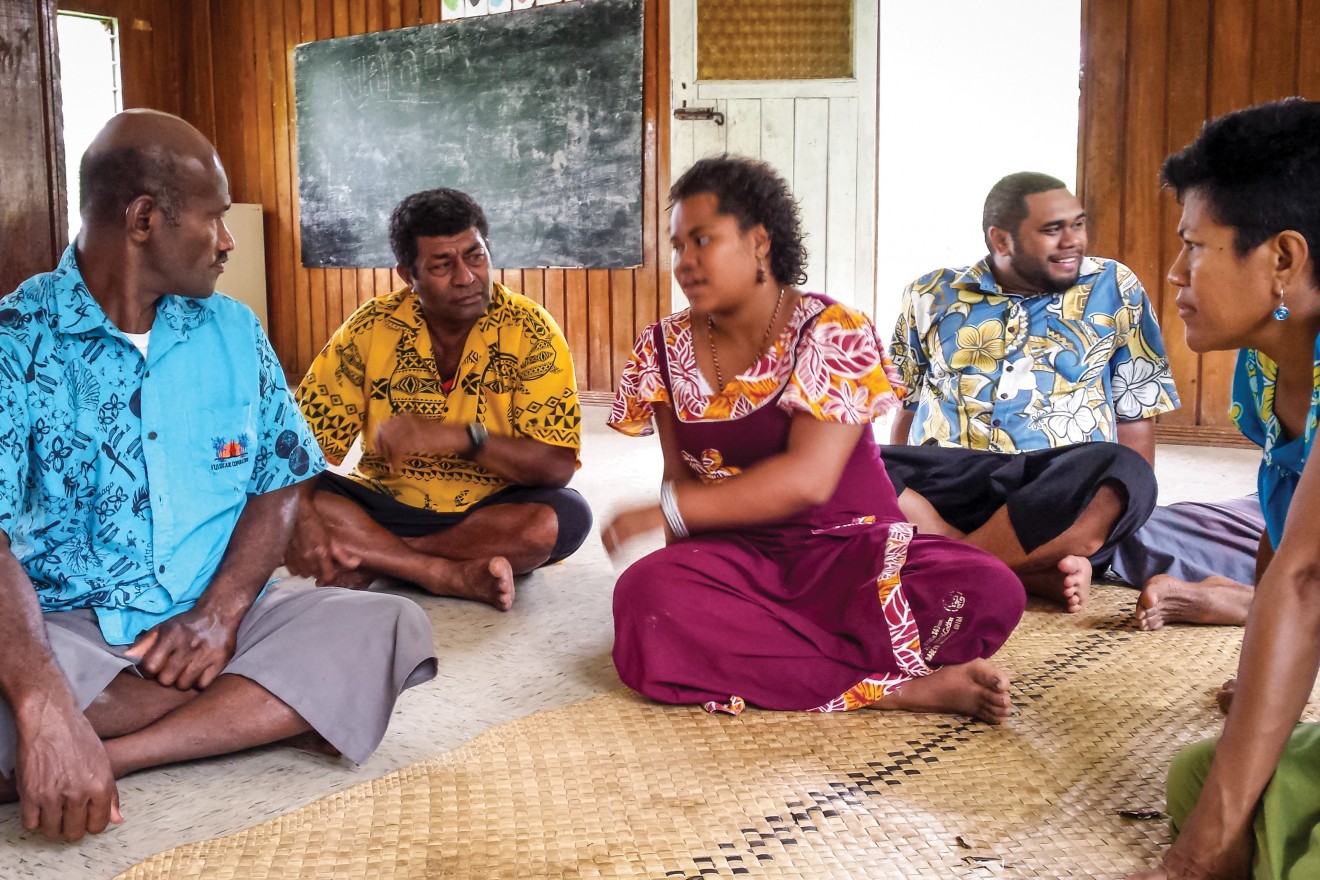
On a muggy, warm December morning, fourteen peacebuilders waited patiently in a rural Fijian village. They had arrived at the appointed hour, yet “Fiji time” prevailed.
A village meeting involving the headman was taking place in the nearby hall. So they waited in a reception room adjoining the man’s house, 12 women and two men from the Pacific Centre for Peacebuilding (PCP), sitting cross-legged on the traditional woven matting that covered the bare wood floor, fanning themselves and idly chatting. Tea arrived, accompanied by plates of jam sandwiches and flatbread soaked in coconut milk, all prepared by a few village women.
The contingent, led by PCP executive director Koila Costello-Olsson, was comprised of staffers from two offices. Those from PCP’s main office, located in Fiji’s capital of Suva on the largest island of Viti Levu, had journeyed to Vanua Levu, the second-largest island, the previous day – taking an exhausting day-long route by bus, ferry, and then bus to the large town of Labasa, where the northern office is located.
Over the next two days, traversing asphalt and red-mud roads by charter bus (accompanied by a soundtrack of Bollywood dance music played by the Indo-Fijian driver), the PCP group would visit five rural villages where peacebuilding projects had been implemented. The size of the PCP delegation was designed to build trust and emphasize the organization’s commitment to ongoing facilitation, Costello-Olsson said, at a time when NGOs typically come with short-term solutions and then disappear. (During the visits, many villagers mentioned this common dynamic in one-on-one conversations with PCP facilitators: “They come and leave before anything is accomplished,” as one man put it.)
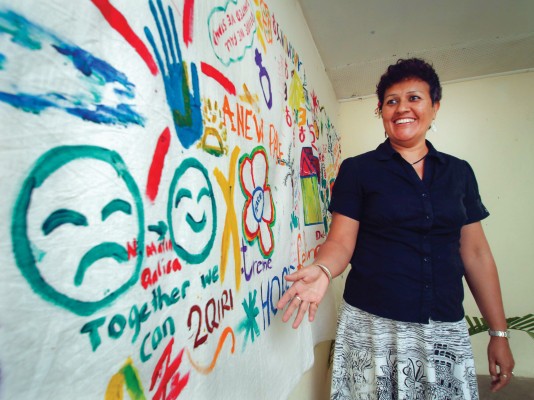
PCP/CJP-style peacebuilding calls for years of commitment and deep wells of good-natured patience. Yet the wait time was also an opportunity for those doing emotionally draining work in often-difficult circumstances to share laughter, to pause and reflect on the goodness of a warm smile of a stranger, curious children, chickens pecking, and the bright vivid beauty of verdant hillsides visible through unglassed windows.
For Costello-Olsson, such rare informal time with her staff is an opportunity to see their camaraderie and resilience, and to re-affirm and restore her vision for what has become one of the largest peacebuilding organizations in Pacific island-nations that are struggling for post-colonial stability and democratic governance.
Since its founding in 2007 by Costello-Olsson, MA ’05, Paulo Baleinakorodawa, MA ’04, and 15 others who weren’t connected to CJP, the Pacific Centre for Peacebuilding has trained village leaders, women’s groups, politicians, pastors, civil servants and members of the police and military in applicable combinations of restorative justice; stress and trauma awareness and healing; inter-ethnic dialogue; and conflict analysis, prevention and resolution. Workshops and trainings are designed to meet the needs of the specific group and the challenges they face.
“Our vision is Pacific people transforming, reducing, and preventing violent conflicts,” said Costello-Olsson. “We want to raise awareness about the concepts of peacebuilding and conflict transformation, strengthen people’s existing tools, and build a network of empowered people who can listen, analyze and intervene in a mindful and positive way,” whether that person is a wife and mother sharing her voice in the village women’s group or a professional working on environmental issues or in a government ministry office.
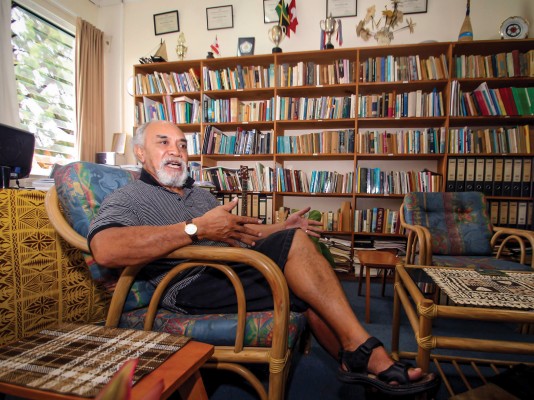
PCP’s area of influence includes 12 sovereign nations within the South Pacific island groups of Polynesia, Micronesia and Melanesia – an expanse that covers tens of thousands of islands and many tribal groups with their unique customs and languages. With its central geographic location and infrastructure, Fiji is the base for much of the region’s education and training; the island has two major centers of education, the University of the South Pacific and Pacific Theological College. (The theological college works collaboratively with PCP, as will be explored later.)[1]
Because outreach is inclusive – participants come from Bougainville, Fiji, Papua New Guinea, Samoa, the Solomon Islands, West Papua, Tonga and Vanuatu, among other island nations – it is important that this work move forward with a respectful, “hybrid approach” that taps the traditional peacebuilding and conflict resolution practices of those cultures, Costello-Olsson added.
Breadth, depth of challenges
Each location also has its own challenges. The Solomon Islands, for example, were wracked by armed conflict from early 1998 to mid-2003, which not only claimed hundreds of lives, but saw thousands displaced from their homes, the use of children as soldiers, and widespread raping of women and girls.[2]
Though each conflict in the region has a distinct historic background and cause – traceable often to the dysfunctional layering of colonial practices over indigenous ones – common triggering factors include social issues: economic deprivation; high unemployment rates for male youth; ethnic disparities and misunderstandings; resource extraction and development issues (over 90% of land in Pacific-region nations is communally owned); and governance issues, including non-democratic, transitional and/or weak systems. Gender-based violence and multi-generational trauma have accompanied the foregoing.[3]
The South Pacific region is also dealing with the impact of climate change, resulting in coastal erosion from rising tides, saltwater intrusion that ruins gardens and makes groundwater non-drinkable, and low-lying swamps that are a breeding ground for malaria-carrying mosquitos. In the Fiji Islands, three villages have already been relocated and 45 others are slated for relocation in the near future, with dramatic effects on daily life, culture and economic well-being.[4]
In one village visited by the PCP bus-riders, the residents talked about how buildings are now often flooded at high tide (due to climate change). With loss of farmland comes food insecurity and economic pressures. Children weren’t visible in this village during the day because – it was explained – they were sleeping, fatigued from night fishing expeditions. The elders are painfully aware that their ancestral roots in this village – tied to sacred rituals and extended family networks of support – are under threat. If these villagers have to move, where will they go, and what can be kept intact wherever they land?
Climate change is not an abstract notion in the South Pacific – residents of low-lying small islands, such as Tuvalu, Kiribati, and the Carteret Islands in Papua New Guinea, seem destined to be the world’s first national groupings rendered as refugees due to climate change. Obviously, such displacements can fuel conflict, both within the displaced peoples and externally, as they bump against others in the quest for liveable land.
Though Fiji is an educational center among the Pacific nations, it has not been a haven of stability for the functioning of PCP. Since 1986, Fiji has had four military coups. The most recent one in 2006 ushered in nearly seven years of military dictatorship, which ended with elections in the fall of 2014. At Peacebuilder’s press time, Fiji had a fragile democratically formed government.
In the past several decades, nearly every person in Fiji, including those associated with PCP, know people whose human rights have been violated, including being jailed for peaceful dissent. Contributing factors to these decades of conflict are inter-ethnic dynamics between indigenous Fijians and Indo-Fijians.[5] Compounding the situation, church denominations have taken sides.
For civil society organizations concerned with promoting a healthier society, such instability causes seismic shifts in NGO and governmental funding from out-of-country sources, such as the governments of Australia and New Zealand, the European Union, and UN agencies.
Following the 2006 coup, Costello-Olsson left her position at the Ecumenical Centre for Research, Education and Advocacy to be one of the founders of PCP. Baleinakorodawa, then working for the Columban Fathers, joined her, along with similarly motivated individuals. They envisioned a wider outreach into all sectors (rather than simply a focus on religious organizations) and also an expanded geographic reach.
Four years later, Baleinakorodawa decided to become an independent consultant on peacebuilding matters. Other founding members have since also gone on to other pursuits.[6]
Given the stresses under which PCP operates, it’s not surprising that organizational identity and structures must be constantly revisited. PCP has struggled to reconcile large differences of opinion among staff on a range of matters, including political viewpoints, preferred paths of action, and how to handle perceptions of bias toward stakeholder groups.
Costello-Olsson says PCP has grown mindful of the need to strengthen organizational structures and culture through internal peacebuilding and ongoing training of staff, which consists heavily of young adults under age 30. PCP engages in bi-annual reviews, the second of which is a multi-day retreat with an outside facilitator who aids staff and board members in extensive evaluation of all aspects of the organization. In December 2014, the village visits were an important, though enjoyable, task before this process began.
Ceremonial introductions
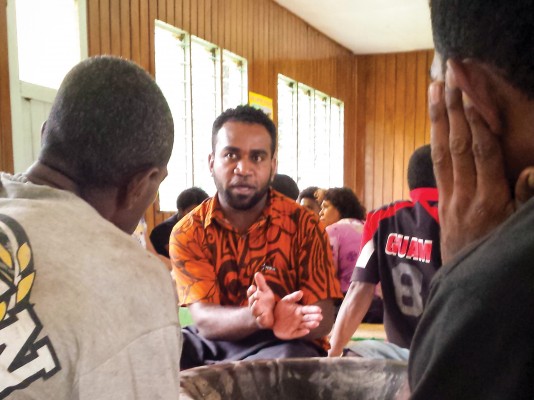
Back in the village community center, the PCP visitors enter barefoot, careful to observe protocols. One’s head must not be higher than the headman, and women’s legs should always be covered. (Both women and men among the visitors are wearing traditional long skirts called sulus that make this a simple task when seated on the floor.)
A traditional gift of thick yaqona root, used in the kava ceremony, is presented by PCP facilitator Veni Cakau. He and the headman alternate a series of short speeches in highly ceremonial language. This protocol, which is always carried out by men using the Fijian language, will enable the group to continue their visit in the village.
After the speeches, Costello-Olsson introduces herself. In a traditional manner but using the English language, she speaks of her father’s island ties and then her mother’s island ties. Depending on historic relationships between the tribes and island groups, this will determine how much levity might be included in social interactions (for example, in one village, Veni is teased mercilessly, and then invited to come back and marry a local girl).
“I am of Fijian, Irish, Samoan, Tongan and English background,” Costello-Olsson says, adding that she is a “real tropical fruit salad,” a common expression for the many mixed heritage islanders, which draws smiles and laughter from the crowd.
“My husband is Max Olsson, and if you recognize that name, yes, he was a rugby player on our national team,” she says, and waits for the appreciative noises and nods. Rugby is the national sport of Fiji and its players are celebrities.
Costello-Olsson’s introduction includes mention of her two children, as well as an explanation of her work with PCP. To see Costello-Olsson in this very real relationship-building among indigenous Fijians engaged in subsistence farming and fishing allows one to gain an appreciation for the very different cultural worlds she straddles: from her native island, where she earned a diploma from the University of the South Pacific, to a university education in Australia to graduate school at Eastern Mennonite University. On behalf of PCP, she’s traveled the world in recent years throughout the Pacific region and to Africa, Europe, Asia, and the United States.
Costello-Olsson’s relationship with EMU began in 2001, when she sent an email to John Paul Lederach, founding director of the Center for Justice and Peacebuilding, asking for help in finding facilitators for Fiji’s first peacebuilding conference. Lederach recommended CJP professor Lisa Schirch, who gave a keynote talk at that conference and co-facilitated. She also encouraged Costello-Olsson and Baleinakorodawa to embark on longer-term study in peacebuilding. Costello-Olsson earned her graduate degree mainly through attending EMU’s Summer Peacebuilding Institute in 2003, 2004 and 2005. She returned to SPI for further training in 2008 and to co-teach in 2009.[7]
In the summer of 2011, Costello-Olsson was among the 18 experienced global peacebuilders (including fellow CJP graduate and 2011 Nobel Peace laureate Leymah Gbowee) who developed the broad outlines of the Women’s Peacebuilding Leadership Program (explored further on pages 64 and 76 in this Peacebuilder).
The development of PCP has gone hand-in-hand with strengthening academic and ecumenical ties in the region. Since 2010, PCP has partnered with Pacific Theological College to run a Pacific Peacebuilding Training Intensive (PPTI) for three weeks each year.[8]
PPTI has trained about 200 religious and civil leaders in the principles of conflict analysis, trauma healing and conflict resolution. In 2013 and 2014, PPTI hosted “Training of Trainers” sessions, which then expanded the network into other South Pacific countries.
Traditions versus change
Incorporating traditional customs and methods of resolving conflict into current peacebuilding practices sounds like a no-brainer, but it does present challenges in a society that is highly patriarchal and filled with violence. This is the current reality throughout the South Pacific islands, regardless of how this came to be historically.
As a positive example of traditions, everybody nodded when the Solomon Islands Truth and Reconciliation Commission encouraged restoring the social fabric of war-torn communities – and reintegrating victims and ex-combatants – through activities such as traditional dances, cleansing ceremonies, and rituals to bless and heal the bush, land, rivers and sea. (A founding board member of PCP, Ratu Joni Madraiwiwi, was one of the three members of this Truth and Reconciliation Commission.) Equally lauded was the symbolic exchange of food and traditional shell money in the Solomon Islands between conflicting parties, marking reconciliation and forgiveness.
Yet what about this common tradition in the Solomon Islands? The male relatives of a rape victim visit the male relatives of the perpetrator and insist that the perpetrator (if single) marry the victim (whether the victim wishes this or not). The victim’s family also expects compensation, which is typically transferred between male relatives (uncles, brothers, fathers), and serves to pacify the male relatives and reconcile the families involved. The victim’s wishes and needs (perhaps for medical attention, counseling, and her idea of justice) are not part of the picture.[9]
One of the major challenges that PCP-trained peacebuilders face, then, is how to encourage their communities to retain life-giving, healthy traditions, but to give up or transform ones that are oppressive, even life-threatening, to women and other groups.
The village community hall, for example, is a multi-purpose communal space: for this PCP visit, it was used to welcome strangers, perform traditional greeting ceremonies, and offer the hospitality of a meal. But PCP facilitator Sindhu Lata Prasad, one of two Indo-Fijian women working in the Labasa office, shared that she often spent the night in such halls when conducting workshops in rural villages more than a half-day’s travel away: “The first time I did it was the first time I had gone into an I-taukei village,” Prasad said, using the common term for indigenous Fijians. “And it was the first time they had hosted an Indo-Fijian.”
That the village space is opened to a woman in a leadership role, traveling alone, much less a woman from a different culture with which there are historic tensions, shows a willingness on many levels, from many stakeholders, to broaden and apply traditions in a new way that fosters mutual understanding.
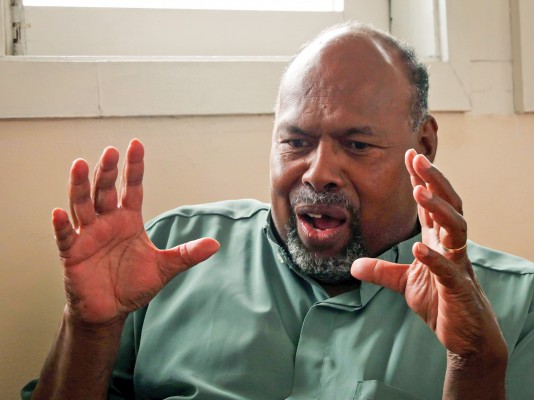
“We need to train men and women,” says PPTI trainee Kelera Nai Cokanasiga, who heads House of Sarah, a counseling service in Suva, Fiji, administered by the Association of Anglican Women. “We can’t only help one side. They have to live together. That is peacebuilding.”
Cokanasiga sees a great need for the clergy to become advocates for women, and ecumenical programs such as PPTI offer ways for this training to begin.
“This [PPTI] training has provided a great impact in all lines of the work I have done,” says Cokanasiga. From using conflict analysis to facilitating circle processes with women traumatized by domestic violence, she says the skills learned in PPTI have helped her train other counselors and work with survivors as well.
Among the diverse denominations served by PPTI’s trainings are leaders of the Methodist Church, the largest denomination on the island, connected to 34% of the population (and 66% of the indigenous Fijians), according to the last census in 1996.[10]
In Fiji, a history of politically led subjugation of the Methodist church has made lifting up and valuing voices of all citizens a priority for The Rev. Jerry Waqainabete, supervisor of the Wesley district (English-speaking) churches in Fiji, who recently spoke on gender-based violence and climate change at the UN headquarters in New York City.
“We can never win this struggle for empowering women if you sit in the back of the room,” he tells women at church meetings. “I tell them, ‘Come up here. When we sit at the table, we are all at the same table.’”
Elizabeth Leasiolago, who is married to a Samoan pastor getting a doctorate at Pacific Theological College, says, “I used to wonder what I could do to help my husband.” But after trainings at PPTI, she says she now recognizes “the skills I have and the changes I can help make in issues that we need to pay attention to. When we return to Samoa, I plan to reach out to women in the congregation and to help them see that they can also make changes.”
Footnotes
- Major funders of PCP have included Bread for the World-Germany, Conciliation Resources, International Women’s Development Agency, European Union, and United Nations Development Programme-Strengthening Capacities for Peace and Development (UNDP-CPAD).
- Abuse of women in the Solomon Islands was worsened by warfare, but it existed before 1998 and has continued since 2003. Research by the Solomon Islands Family Health and Safety Study, published in 2009, found that 64% of women aged 15 to 49 who had ever been in an intimate partner relationship had experienced physical and/or sexual violence by their partner in severe forms, such as punching, kicking or having a weapon used against them (as compared to somewhat lesser violence, such as being slapped or having objects thrown at them). Such treatment began early – 37% of women in this age group reported having been sexually abused before the age of 15.
- A study in The Lancet, published September 10, 2013, found that 41% of men on Bougainville Island, Papua New Guinea, reported having raped a non-partner and 14.1% reported having committed gang rape.
- Reported at the February 2015 Climate Change and Health Adaptations Symposium, Suva, Fiji. (pidp.eastwestcenter.org/pireport/2015/February/02-13-03.htm)
- Most Indo-Fijians are the descendants of Indian indentured laborers, called girmitiyas, who were brought by British colonial authorities to work in the sugar fields, although some are descended from a later wave of free settlers from different provinces and castes in India.
- Leadership and staff turnover in peacebuilding institutes, particularly in their formative years, is the norm, as other articles in Peacebuilder show – especially in highly unstable environments.
- The summer of 2015 marks Costello-Olsson’s eighth teaching stint at SPI – she’s co-teaching a course on adult-centered learning, “Training Design and Facilitation.”
- The success of this training has led the Pacific Theological College to add a program of such studies to its regular pastoral curriculum, under the direction of Rev. Rosalyn “Rosa” Nokise, who attended SPI in 2013. In an interview with Peacebuilder, college principal The Rev. Dr. Felese Nokise (Rosalyn’s husband) was enthusiastic about the possibility of offering a graduate program in peacebuilding.
- The examples in this paragraph and the preceding one come from “Confronting the Truth for a Better Solomon Islands,” which is Vol. III of the Final Report of the “Solomon Islands Truth and Reconciliation Commission,” published February 2012. (pacificpolicy.org/files/2013/04/Solomon-Islands-TRC-Final-Report-Vol-3.pdf)
- A 1996 census by the Fiji Island Bureau of Statistics provides the most recent data of population by religion and race. A 2007 census tallied only population by religion. These statistics may be found at: www.spc.int/prism/fjtest/Social/religion_stats.htm.